Asus P4S800D-E Deluxe & Gigabyte 8S655TX Ultra: SiS 655TX Challenges Intel's Best
by Wesley Fink on December 9, 2003 1:52 PM EST- Posted in
- Motherboards
Gigabyte 8S655TX Ultra: BIOS and Overclocking
BIOS
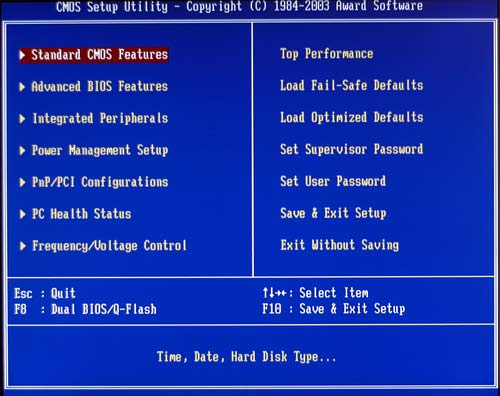
Gigabyte uses the Award BIOS familiar to most AnandTech readers. The operation should be familiar, except that Gigabyte has a hidden menu for many of the adjustments most used by enthusiasts. If you look closely, you will see that the “Advanced Chipset Features” menu is missing.
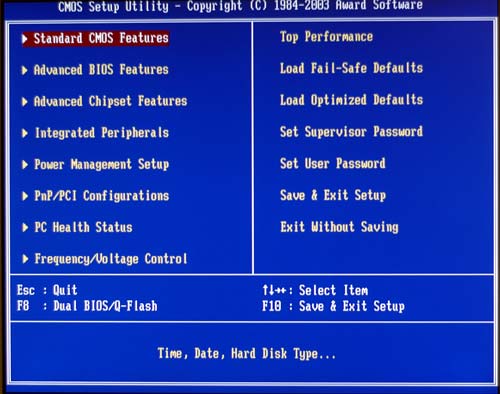
To bring up the hidden “Advanced Chipset Features”, go into BIOS, then hold down CTRL+F1. When the keys are released, the hidden submenu appears in the main menu and can be selected.
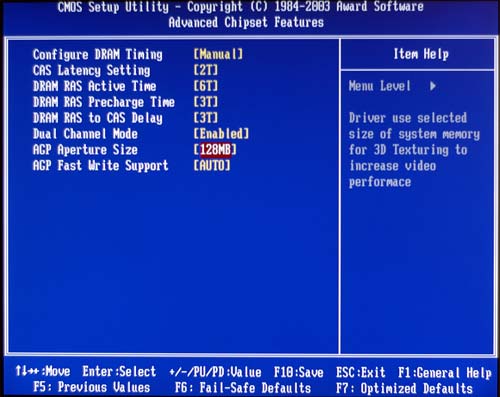
Memory Timings are adjusted in the hidden “Advanced Chipset Features” menu.
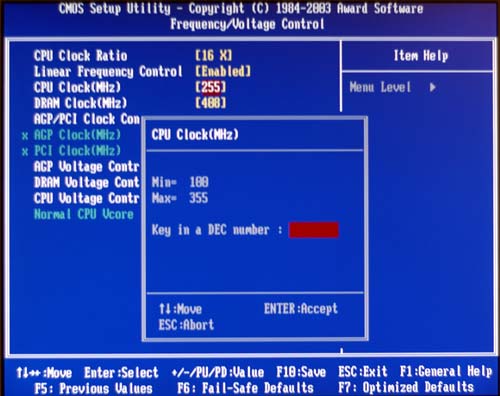
Frequency/Voltage Control is where enthusiasts will spend a lot of time. Here, the FSB can be adjusted from 100-355. Voltages are also adjusted here, though the adjustments for memory voltage are extremely disappointing. As Gigabyte has done on some other boards, the only vDIMM adjustments are Normal and +0.1V. With many DIMMs specifying a standard voltage of 2.75V and certifying their stability at 3.0V, this adjustment range is ridiculous for a board clearly aimed at the Computer Enthusiast. We have contacted Gigabyte with our concerns and suggested that they add better vDIMM options to the 8S655TX Ultra.
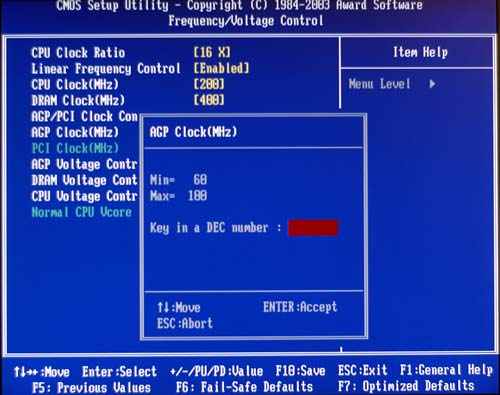
Gigabyte provides the option to either let the AGP/PCI bus float with the setting of the FSB, or to fix the AGP/PCI at 66/33 or any other setting from 60 to 100. For the massive overclocking that is sometimes possible with Intel Pentium 4 processors, the ability to fix the AGP/PCI bus is absolutely essential to achieving the highest overclock levels that the CPU can achieve.
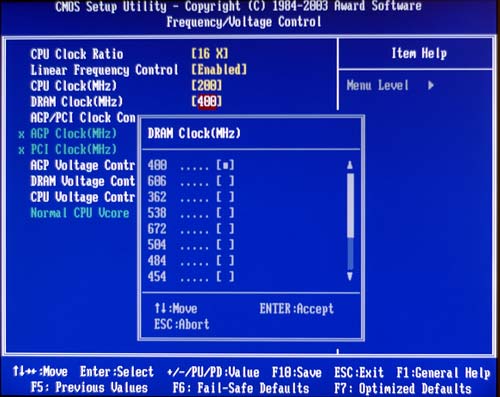
Historically, Gigabyte has offered a very wide range of memory ratios on their Intel SiS boards. We are pleased to see that this is also the case with the 655TX. Ratio choices at DDR400 are mind boggling: 200, 242, 266, 322, 333, 362, 400, 454, 484, 504, 538, 606, and 672. A very nice feature of the Gigabyte menu is that, unlike the Asus ratios, the ones in the Gigabyte menu change with the selected FSB setting. A different set of ratios appear at a setting of 233, for example. We did not test all the available ratios, but on past Gigabyte boards, some ratios worked fine and others did not, depending on the selected FSB. Regardless, you should be able to find a setting for whatever memory you wish to run on the 8S655TX Ultra.
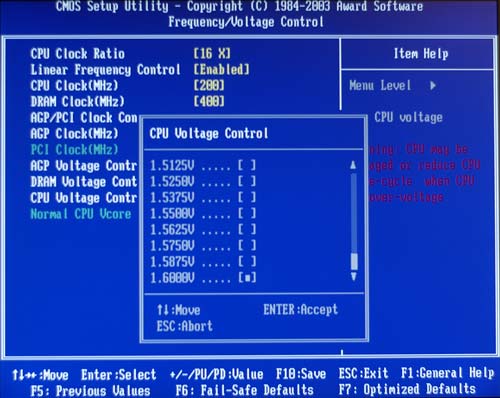
Consistent with its design for Prescott support, the 8S655TX Ultra provides voltages from 1.6V at the top...
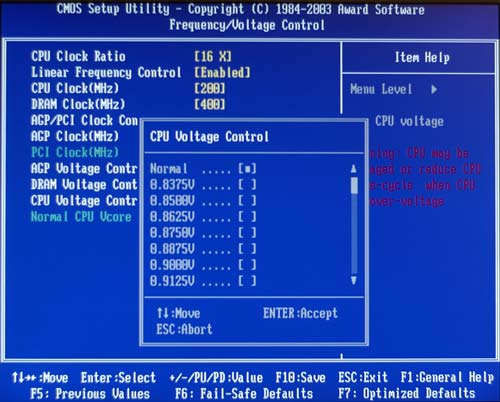
...to 0.8375V on the bottom. Increments are 0.0125V.
FSB Overclocking Results
Asus and Gigabyte have, in the past, produced the best SiS Intel chipset boards that we have tested. However, on the most recent SiS chipsets, Gigabyte has produced the boards that define the market segment. The SINXP really had no equal from Asus, so we fully expected the Gigabyte to be the board to beat in our benchmarking. To our surprise, the Gigabyte turned out to be a much poorer overclocker than the Asus.| Front Side Bus Overclocking Testbed Default Voltage |
|
| Processor: | Intel Socket 478 3.2 ES |
| CPU Voltage: | 1.55V (default) |
| Cooling: | CoolerMaster IHC-L71 Silent Heat Pipe |
| Power Supply: | Enermax 465W |
| Maximum OC: | 3630 (15x242) 242 |
The above overclocking setup at default voltage allowed us to reach the highest stable FSB of 242 (968) at 1:1 memory ratio. This was also the highest overclock that we could achieve with an asynchronous memory setting. Frankly, this is a very disappointing performance for a board designed to compete with Intel's 865/875 chipsets. A lower ratio would not allow a higher bus setting. Above 242, the system tried to boot, but failed a complete boot or was very unstable. We have seen other reviews that only reached 210FSB on the Gigabyte, so our overclocking is quite good compared to what some others have found. Gigabyte clearly has their work cut out to produce a BIOS that will be competitive with the Asus P4S800D-E and Intel 865/875 chipset boards.
Up to 242, the Gigabyte with the M3 pre-release BIOS was stable and fast, but this overclocking will only satisfy those Pentium 4 enthusiasts with the fastest P4 chips that have limited overclocking abilities. Asus has proved the limitation is not the 655TX chipset, but rather, the BIOS or design of the board, and Gigabyte needs to fix this problem quickly.










24 Comments
View All Comments
FFS - Wednesday, December 10, 2003 - link
Q? to Wesley does these mobos have control of CPU fan speed (again like MSI Neo2), so it run more slow with low CPU load (= more silent)?Another one is how it's compatible with Radeon 9700 Pro? F.e. My SIS648 even with latest SIS-AGP drivers have have a conflict with Hercules R9700Pro when Fast Write is turned on...
Competition is G R E A T E thing,... but you know we also want stability :))) So far, as I know Intel chipsets before were far more stable and compatible with other hardware...
The bottom line "as fast" does not always mean "as good"... :(( And since I also love competition let's hope that SIS655TX as good as 875P.
ripdude - Wednesday, December 10, 2003 - link
A good article on a serie of good boards, I'm very happy you took the P4C800-E dlx in the test.I'm more then happy with the increased competition these boards bring, the P4C800-e dlx is still about 199 in euro land.
SmoiL - Wednesday, December 10, 2003 - link
When is the Asus P4S800D-E coming out? Nada on pricewatchWesley Fink - Wednesday, December 10, 2003 - link
Several of the cells in the Feature Table on page 3 were reversed and have now been corrected.Dual Channel (2x64 bit) is called 128 bit mode on the SiS. The BIOS has the option to run 128-bit (Dual-Channel) mode or to force Dual 64-bit.
FFS - Tuesday, December 9, 2003 - link
Also, as I remember VIA VT6307 support 3 (not 2) 1394a FireWire ports (as on MSI Neo boards), so why Gigabyte would cut them to 2 ???And besides Wesley always trying to stress out color-coded panel connectors.
For me it's more important that you can change RAM without taking off videocard and ASUS had such problems with some of their mobos (now it looks better... but talking about overclocking ... hmmmm.
Even it's damn stable: heatsink on ASUS SiS 655TX is passive (already -) and too close to CPU (plus wrong orientation - same mistake as with original
P4C800 Deluxe. So - NO oversized cooler for CPU on this board.
FFS - Tuesday, December 9, 2003 - link
Realtek ALC658 codec AC '97 2.36-Channel with UAJ Shoud go to Gigabyte and vice versa...
Oh well.., I had my SIS648 for a while and .. so now I'd rather prefer to pay eXtra for board with Intel chipset :((
Plus Gigabit LAN will work faster(=better) with CSA...
FFS - Tuesday, December 9, 2003 - link
Hey guys... In the features table on-board audio codecs are mixed up :)Shalmanese - Tuesday, December 9, 2003 - link
Er, I don't think Sis supports 33Mhz Memory speeds... (pg 5) ;).What happened to the tech support turnaround time bit? That was always the favourite part of your reviews.
Tokelil - Tuesday, December 9, 2003 - link
On page 3 it says its the Gigabyte MB that uses the Marvel Gigabit controller, while on page 4 it says its the asus board that uses the Marvel controller... My guess is it is Asus that uses it and its wrong on page 3.FishTankX - Tuesday, December 9, 2003 - link
What on earth is the difference?There is no commercially avaliable 128 bit DDRSDRAM. All DDRSDRAM is 64 bit.